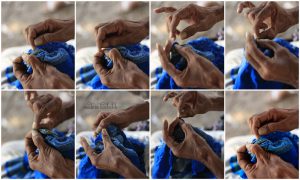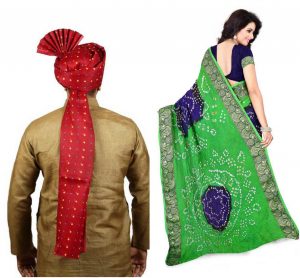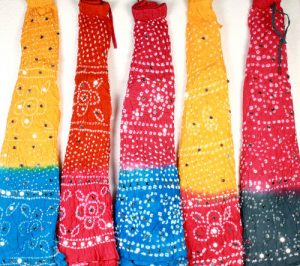Bandhani is an Indian traditional art form of tie and dye. Bandhani is one of the famous textile patterns in India.The name Bandhani came from the word Bandhej which symbolizes “Tying” in Gujarati.
Tie And Dye in India
Bandhani is an old artwork that is mainly done in the state of Rajasthan and Gujarat of India. Somewhere around 5000 years ago Indian Tie & Dye or Bandhani was initiated. Places of Rajasthan like Jaipur, Sikar, Bhilwara, Udaipur, Bikaner, Ajmer, and Jamnagar in Gujarat are the well-known centers producing odhnis, sarees, and turbans in Bandhani.
Different communities of Rajasthan in India follow the tradition for ages of tying turbans with various patterns of bandhani artwork on their heads. These were used to identify which community the person belonged to. In the olden days, dyes were extracted from roots, flowers, leaves, and berries, etc.
Because of various linguistic variations, these sarees are also called bandhej sarees, Piliya, Chungidi, Ghar Chola, and Patori Bandhani, among other names. These sarees used to be worn during royal weddings, and the printing technique was first introduced in Gujrat.
The process of making bandhani clothes involves a complicated process.It requires a lot of man work.
There are various types of dyes used in this process like:
• Vat dyes: These are the natural dyes. Cotton and woolen clothes are dyed with vat dyes.It is the direct type of application of color.
• Direct dyes: It is popularly known as hot water dyes. This process is used in most of the kinds of types of fabrics like cotton, silk, nylon and wool.
• Naphthol Dye: This method includes combining of two chemicals, it produces a third colorful product by reacting to it. The fabrics are dyed with one and printed with the other. The major drawback for this kind is that not many chemicals of this type are available which can produce more colors on reacting.
• Procion Dye: It is a method that is mostly used on cellulose fabric clothes like cotton, linen, and rayon. It is a ‘cold water’ process used in solar dyeing, tie and dye and batik.

Steps involved for making Bandhani’s are:
• Prepare the fabric by de-starching. Destarching is done by soaking cloth overnight.
• The extra water is removed by squeezing it out.
• The dye is made.
• The material is immersed in it. The pattern depends on the knots in the clothes.
Market
Bandhani has its market spread all over India.The demand is increasing over the past few decades. Sales go up during the festive and wedding times in India. The bulk of the market is domestic with the primary market being in Gujarat.




